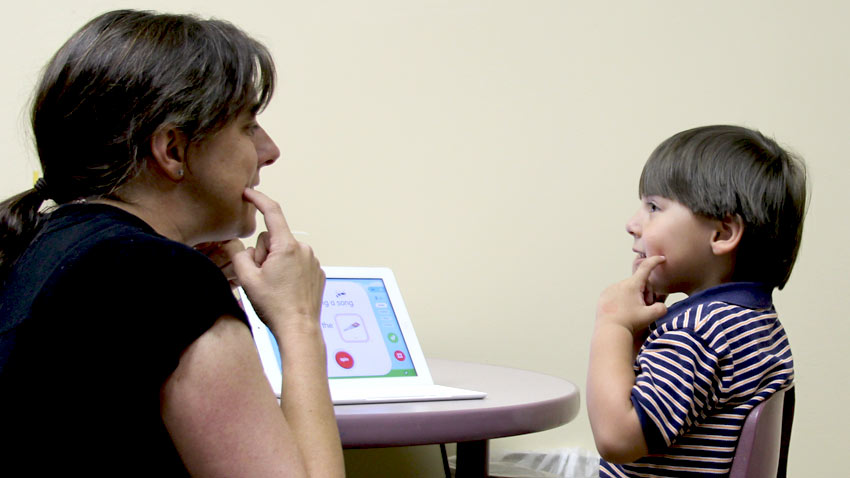
Articulation Disorders may cause a person to person to omit sounds within words, add sounds that are not part of words, substitute and / or distort sounds when speaking.
Frontal lisp is one of the articulation disorders. This child produces "s" with his tongue forward.
Articulation Disorders can become evident as children acquire speech and language. Articulation of speech emerges over time, and is generally imperfect during the early stages of acquisition. This is completely normal. Speech sounds gain precision over time. However, some speech sound errors are not normal, and can indicate a problem. Cobblestone speech-language pathologists can determine if a child has a disorder of articulation based on his or her age. We compare the type of speech errors and the quality of the errors that the child produces with statistical norms and what is expected of the child at his or her age. Developmental guidelines are utilized when assessing a child's speech production.
Young children often make speech errors. For instance, many young children sound like they are making a "w" sound for an "r" sound (e.g., "wabbit" for "rabbit") or may leave sounds out of words, such as "nana" for "banana." The child may have an articulation disorder if these errors continue past the expected age.
Decreased clarity or intelligibility of speech in older individuals can occur for many other reasons including dental problems, accidents, illnesses affecting the mouth and tongue, and more. These problems can be helped through speech therapy as well.
SLPs provide treatment to improve articulation of individual sounds or reduce errors in production of sound patterns.
Articulation treatment may involve demonstrating how to produce the sound correctly, learning to recognize which sounds are correct and incorrect, and practicing sounds in different words. Phonological process treatment may involve teaching the rules of speech to individuals to help them say words correctly.


My husband and I are grateful to Cobblestone for everything they have done for our daughter Scarlett. We have had the pleasure of working with Lynn and it has been a life changing experience for our whole family. Scarlett has gained so much confidence in her abilities and we feel fortunate to have had this opportunity to work with them on her speech goals. We know that with their tools she will have a different level of learning than that of her peers. In addition, Jodie has been a delight to work with from getting us started to answering any questions we have in a timely manner. They treat you like part of the family and they truly care about your child.
Alana Kelly – 8 year-old daughter
We moved here last year and found Cobblestone to continue my then 4 year olds Apraxia therapy with Miss Samantha. Last week he had his last session. It’s been a wonderful year working with Samantha and Lynn and we are going to miss them so much. Samantha was a great therapist and worked so well with my son. Lynn is such a wonderful, kind, and caring woman and I truely enjoyed our afternoon chats. She runs her business so professionally, yet when you walk in the door, you feel like family. We had some issues with our insurance company and she worked so hard to get things fixed so that we didn’t have to deal with them ourselves.
Stacy Cote – 4 year-old son
We love Cobblestone! We have worked with several therapists over the past 3 years at Cobblestone. Each one has been easy to work with and adaptable to my sons needs. Due to Covid restrictions, we are seeing Kimberly remotely every week. I wasn't sure if remote therapy would be a great fit for my son, but she has made the transition extremely easy and engaging. He continues to work on and gain skills with every session. Kimberly is able to hold his attention for most of the session. Way to adapt Cobblestone! Thank you.
Jenn Grey –5 year-old son
First visit: Your first visit is an opportunity for the therapist, child and yourself to meet prior to an evaluation or intervention. You are welcome to bring siblings and other family members to this visit. The therapist will take this opportunity to informally observe your child's communication and play skills ... Learn more »
First visit: You will be coming to visit me soon at my office. When you arrive I will greet you and we will have some time to play and get to know each other. I will show you where the games and toys are and you will be able to pick out a couple that we can play with together ... Learn more »
7761 Shaffer Pkwy
Ste 140
Littleton, Colorado 80127
Phone: 303-952-9038
Fax: 720-622-9901